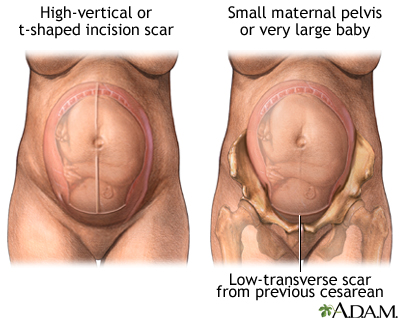| ||||||||||||||||||||||||||||||||||||||||
Vaginal Birth After C-Section (VBAC)
The old phrase "once a C-section always" is no longer true. In the past, the belief was that if a woman had delivered one baby by C-section, all other children had to be delivered the same way. Today many women can have vaginal deliveries after a previous C-section delivery. This is referred to as a vaginal birth after cesarean (VBAC). Attempting to have a vaginal birth after a previous cesarean section is called a trial of labor after cesarean (TOLAC).
Candidates For VBAC
According to the American College of Obstetricians and Gynecologists (ACOG), the following women are candidates for TOLAC:
- The woman has had no more than one prior low-transverse C-section delivery. This refers to the cut on your uterus, not the one on your belly. If you’ve had a prior c-section, your health care provider may ask you to get a copy of the report from your first surgery to check what type of incision you had on the uterus.
- The woman has had no other uterine scars or ruptures, whether from previous C-sections or other surgeries.
- The woman has a pelvis large enough to allow a vaginal delivery.
- Delivery will be at an institution with a physician immediately available throughout active labor who can monitor the fetus and perform an emergent C-section if needed.
- Delivery at an institution where anesthesia and staff is also immediately available if an emergent C-section needs to be performed.
ACOG has specifically stated that whenever a woman is planning a TOLAC delivery, there should be an appropriate medical team available, including an anesthesiologist, throughout the active labor so that an emergency C-section may be done if necessary. Smaller hospitals may not have the resources to monitor a VBAC delivery or to provide an emergency c-section for TOLAC situations, and VBAC delivery may not be possible.
Women Who Should NOT Have VBAC
One of the main concerns with having a vaginal delivery after a C-section is the potential rupture of the uterus, which could be harmful to you and the baby. Therefore, ACOG has made recommendations for women who should not try a VBAC delivery. These women include:

- Women with a high vertical (or classical, T-shaped) incision on the uterus
- Women with a history of extensive uterine surgery
- Women with a small pelvis or delivering a large baby - it may not be safe for the baby to pass through the pelvis
- Those with a medical problem or obstetric condition, such as placenta previa or abruptio placenta
- Women delivering in a hospital without an available medical team for VBAC monitoring and emergency C-section
- Prior uterine rupture
- Women with more than two prior C-sections and no previous vaginal deliveries
The Benefits of VBAC
Statistically, about 60-80% of women who try TOLAC are able to deliver vaginally. If you are considered a candidate for VBAC, there are some advantages to having a vaginal delivery over a C-section. Some of these include:
- Shorter hospitalization
- No abdominal surgery
- Lower risk for blood transfusion and infection
- Overall faster recovery
- May avoid multiple future c-sections if you are considering a large family (with three or more children)
Notably, however, some women who try to have a vaginal delivery end up with a c-section. They don’t get to experience these benefits.
Risks
The most serious risk with TOLAC is rupture of the uterus. The risk of rupture of the uterus after a prior low transverse c-section is about 1 percent, whereas the risk of rupture of the uterus in previous classical C-section is 8 to 10 percent. In a recent large study, about 1 in 2,000 women who tried to TOLAC had a uterine rupture that caused permanent brain damage for the baby. Women in the group that tried to have a vaginal delivery were also more likely to need a blood transfusion and more likely to have an infection in their uterus that required antibiotics. On the other hand, about three quarters of the women who tried to have a vaginal delivery succeeded. These women avoided surgery and had a quicker recovery compared with the women who chose to have a scheduled repeat c-section.
The Final Decision Is Yours
The key to making a decision about TOLAC is to discuss with your health care provider the risks and benefits for both you and your baby. The circumstances are different for everyone, and it is important to seek guidance from your health care provider to discuss your risks.
Ultimately, the decision is yours. The more information and understanding you have about TOLAC, the easier it will be to make a decision.
|
Review Date:
12/9/2012 Reviewed By: Irina Burd, MD, PhD, Maternal Fetal Medicine, Johns Hopkins University, Baltimore, MD. Review provided by VeriMed Healthcare Network. |




